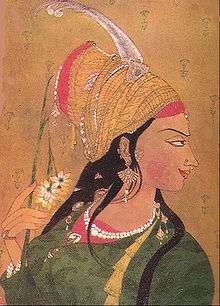Culture of Pakistan
Culture of Pakistan (Urdu: ثقافتِ پاکستان S̱aqāfat-e-Pākistān) is intertwined with the culture of the broader Indian subcontinent and Central Asia. Comprises numerous ethnic groups: the Punjabis, Saraikis, Pothwaris, Kashmiris, Sindhis, Muhajirs, Makrani in the south; Baloch, Hazaras and Pashtuns in the west; and the Dards, Wakhi, Baltis, Shinaki and Burusho communities in the north. The culture of these Pakistani ethnic groups have been greatly influenced by many of its neighbours, such as the other South Asian, Iranic, Turkic as well as the peoples of Central Asia and West Asia.
| Part of a series on the |
| Culture of Pakistan |
|---|
 |
| Traditions |
|
Mythology and folklore
|
| Cuisine |
|
Festivals |
|
Art
|
|
Literature |
|
Music and performing arts
|
|
Media
|
| Sport |
|
Monuments |
|
The region has formed a distinct unit within the main geographical complex of Indian subcontinent, the Middle East and Central Asia from the earliest times, and is analogous to the intermediary position of Afghanistan.[1] There are differences among the ethnic groups in cultural aspects such as dress, food, and religion, especially where pre-Islamic customs differ from Islamic practices. Their cultural origins also reveal influences from far afield and indigenous, including ancient India and Central Asia. Pakistan was the first region of the Indian subcontinent to be fully impacted by Islam and has thus developed a distinct Islamic identity, historically different from areas further east.[1]
Literature
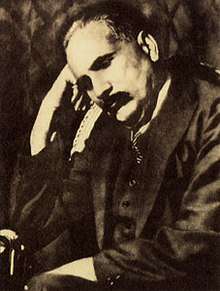
Pakistani literature originates from when Pakistan gained its independence as a sovereign state in 1947. The common and shared tradition of Urdu literature and English literature of Greater India was inherited by the new state. Over a period of time, a body of literature unique to Pakistan emerged, written in the major languages, including Urdu, English, Punjabi, Pashto, Seraiki, Balochi, and Sindhi.
Poetry
Poetry is a highly respected art and profession in Pakistan. The pre-eminent form of poetry in Pakistan almost always originates in Persian, due in part to the long-standing affiliation and heavy admiration the region's rulers once had for certain aspects of foreign Persian culture. The enthusiasm for poetry exists at a regional level as well, with nearly all of Pakistan's provincial languages continuing the legacy. Since the independence of the country in 1947 and establishment of Urdu as the national language, poetry is written in that language as well. The Urdu language has a rich tradition of poetry and includes the famous poets Muhammad Iqbal (national poet), Mir Taqi Mir, Ghalib, Faiz Ahmad Faiz, Ahmad Faraz, Habib Jalib, Jazib Qureshi, and Ahmad Nadeem Qasmi. Apart from Urdu poetry, Pakistani poetry also has blends of other regional languages. Balochi, Sindhi, Punjabi, Seraiki, and Pashto poetry have all incorporated and influenced Pakistani poetry.
Performing arts
Music

The variety of Pakistani music ranges from diverse provincial folk music and traditional styles such as Qawwali which is played by men clapping, singing and playing drums and Ghazal Gayaki to modern forms fusing traditional and Western music.
Pakistan is home to many famous folk singers such as the late Alam Lohar, who is also well known in Indian Punjab. The arrival of Afghan refugees in the western provinces has rekindled Dari music and established Peshawar as a hub for Afghan musicians and a distribution center for Afghani music abroad.
Dances
Kathak The origin of Kathak is traditionally attributed to the traveling bards of ancient northern India known as Kathakars or storytellers.[2] The term Kathak is derived from the Vedic Sanskrit word Katha which means "story", and Kathakar which means "the one who tells a story", or "to do with stories". Other dances of Pakistan includes:
Balochistan
- Lewa - Baluch folk dance from Makran region
- Chap - Baluch folk dance performed at weddings
- Jhumar - Saraiki, and Balochi folk dance
- Attan - Pashtun traditional dance from northern regions of Balochistan.
Khyber Pakhtunkhwa
- Attan - Folk dance of Pashtuns tribes of Pakistan including the unique styles of Quetta and Waziristan
- Khattak Dance - sword dance of Khattak tribe in Khyber-Pakhtunkhwa
- Jhumar and Gatka - Popular dance of hazara division Khyber-Pakhtunkhwa
- Chitrali Dance - Khyber-Pakhtunkhwa
- Kumbar - folk dance of Hazara
Sindh
Drama and theatre
These are very similar to stage plays in theatres. They are performed by well-known actors and actresses in the Lollywood industry. The dramas and plays often deal with themes from everyday life, often with a humorous touch.
Visual arts
Painting
During the 16th to 18th centuries, Mughal painting developed, heavily influenced by Persian miniatures. Abdul Rehman Chughtai, Sughra Rababi, Ustad Allah Baksh, Aboo B. Rana, Ajaz Anwar, Ismail Gulgee, Jamil Naqsh, Ahmed Pervez, and Sadequain are prominent and outstanding creative painters of Pakistan. Pakistani vehicle art is a popular folk art.
Architecture

The architecture of the areas now constituting Pakistan can be traced to four distinct periods: pre-Islamic, Islamic, colonial, and post-colonial. With the beginning of the Indus civilization around the middle of the 3rd millennium[2] B.C., an advanced urban culture developed for the first time in the region, with large structural facilities, some of which survive to this day.[3] Mohenjo Daro, Harappa and Kot Diji belong to the pre-Islamic era settlements. The rise of Buddhism, Guptas, Mouryas, and the Persian and Greek influence led to the development of the Greco-Buddhist style, starting from the 1st century CE. The high point of this era was reached with the culmination of the Gandhara style. An example of Buddhist architecture is the ruins of the Buddhist monastery Takht-i-Bahi in Khyber-Pakhtunkhwa.
The arrival of Islam in today's Pakistan introduced the classical Islamic construction techniques into Pakistan's architectural landscape.[4] However, a smooth transition to predominantly picture-less Islamic architecture occurred. The town of Uch Sharif contains the tombs of Bibi Jawindi, Baha'is-Halim, and Jalaluddin Bukhari, which are considered some of the earliest examples of Islamic architecture in Pakistan and are on the UNESCO Tentative World Heritage Site list since 2004.[5] One of the most important of the few examples of the Persian style of architecture is the tomb of the Shah Rukn-i-Alam in Multan. During the Mughal era, design elements of Islamic-Persian architecture were fused with, and often produced playful forms of, local art, resulting in the establishment of Mughal Architecture. Lahore, occasional residence of Mughal rulers, exhibits a multiplicity of important buildings from the empire, among them the Badshahi mosque, the fortress of Lahore with the famous Alamgiri Gate, the colourful, still strongly Mughal-influenced Wazir Khan Mosque as well as numerous other mosques and mausoleums. The Shahjahan Mosque of Thatta in Sindh also originates from the epoch of the Mughals, as does the Mohabbat Khan Mosque in Peshawar.
In the British colonial age, the buildings developed were predominantly of European styles such as gothic, baroque and neoclassical. The Indo-Saracenic style, with a mixture of European and Indian-Islamic components, also developed during this period. Post-colonial national identity is expressed in modern structures like the Faisal Mosque, Pakistan Monument, the Minar-e-Pakistan and the Mazar-e-Quaid.
Recreation and sports
The official national sport of Pakistan is field hockey, but cricket and football are the most popular sports. The Pakistan national field hockey team has won the Hockey World Cup a record four times, 1971, 1978, 1982 and 1994.
The Pakistan national cricket team won the Cricket World Cup in 1992, were runners-up in 1999, and co-hosted the games in 1987 and 1996. They also won the ICC World Twenty20 in 2009 and were runners-up in 2007. The team also won the Austral-Asia Cup in 1986, 1990, and 1994. In 2017, Pakistan won the 2017 ICC Champions Trophy against their rival India. The women's team is yet to win a world cup.
At the international level, Pakistan has competed many times at the Summer Olympics in field hockey, boxing, athletics, swimming, and shooting. Hockey is the sport in which Pakistan has been most successful at the Olympics, winning three gold medals (1960, 1968, and 1984). [6] Pakistan has hosted several international competitions, including the South Asian Federation Games in 1989 and 2004.
A1 Grand Prix racing is also becoming popular with the entry of a Pakistani team in the 2005 season. The Tour de Pakistan, modeled on the Tour de France, is an annual cycling competition that covers the length and breadth of Pakistan. Recently, football has grown in popularity across the country, where traditionally it had been played almost exclusively in the western province of Balochistan. FIFA has recently teamed up with the government to bring football closer to the northern areas.
Cuisine
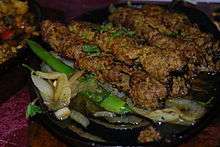
Culinary art in Pakistan is mainly a mix of Indian cuisines with Middle Eastern, Central Asian and Afghan influence. There are variations of cooking practices across the country, mostly from spicy in Punjab and Sindh to steamed and boiled in Khyber Pakhtunkhwa and Balochistan. Urban centers of the country offer an amalgamation of recipes from all parts of the country, while food with specific local ingredients and tastes is available in rural areas and villages. Different specialties exist throughout the country mostly different type of rice like Biryani, Pulao or Boiled rice with vegetables and meat are used with Korma and desserts. There are also local forms of grilled meat or kebabs, Kheer desserts, and a variety of hot and cold drinks.
Tea culture

The consumption of tea in Pakistan, where it is called chai (چائے), its name in Urdu, is of central significance to Pakistani culture. It is one of the most consumed beverages in Pakistani cuisine. Pakistan does produce its own limited tea in Chinkiari (KP) farms, however it ranks as the third largest importer of tea in the world.[7] In 2003, as much as 109,000 tonnes of tea were consumed in Pakistan, ranking it at seven on the list of tea-consuming countries in the world.[7]
While green tea has been an ancient tradition in Pakistan for thousands of years, black tea was originally introduced and popularized during the colonial British era in South Asia. Cities such as Lahore had one of the most vibrant tea cultures, as the drink quickly absorbed into local culture. The shield on the State emblem of Pakistan notably features a tea crop in one of its quarters. Tea is usually consumed at breakfast, during lunch breaks at the workplace, and in the evening at home. Evening tea may be consumed with typically something sweet such as biscuits or cake but can also be served with a savory snack such as samosas, depending on the amount of time one has. Guests are typically offered a choice between tea and soft drinks. It is common practice for homeowners to offer tea breaks to hired labour, and sometimes even provide them with tea during the breaks. Tea offered to labour is typically strong and has more sugar in it.
High teas are common at hotels and restaurants, and are usually buffet-style meals with light snacks.
Tea making techniques vary from home to home, and person to person, but tea is typically made from loose tea leaves and steeped for a couple of minutes before serving. A teapot and tea cosy may be used, if time permits, or tea may be steeped directly in the kettle off the heat. After steeping, the tea is poured into cups through a strainer. Milk may be added before or after the tea, but sugar is typically offered separately so that each individual may add sugar according to his or her own taste. Teabags are usually reserved for when time constraints do not enable one to prepare tea from loose tea leaves.
Tea served is typically black, with milk, although green tea is becoming increasingly popular. While black tea is very rarely consumed without milk, green tea is never served with milk.
Most of the tea consumed in Pakistan is imported from Kenya. After 1995, the Pakistani government began to implement a tea plantation project, which established green tea estates in Pakistan and achieved good performance.
Varieties
Different regions throughout the country have their own different flavors and varieties, giving Pakistani tea culture a diverse blend. In Karachi, the Black tea and Masala chai (Spiced tea) are popular while the thick and milky Doodh Pati Chai is more preferred in Punjab. Biscuits and paan are common delicacies and staples enjoyed with tea. In the northern and western parts of the country, including Khyber Pakhtunkhwa, Balochistan and much of Kashmir, the popular green tea called "kahwah" is predominant.
In Kashmir, Kashmiri chai or "Noon Chai", a pink, milky tea with pistachios and cardamom, is consumed primarily at special occasions, weddings, and during the winter months when it is sold in many kiosks. In the further north Chitral and Gilgit-Baltistan regions, Central Asian variants such as salty buttered Tibetan style tea are consumed.
In popular culture
- The name for Three Cups of Tea, a bestselling book by American mountaineer and educator Greg Mortenson, is taken from the Balti proverb in northern Pakistan: "The first time you share tea with a Balti, you are a stranger. The second time you take tea, you are an honored guest. The third time you share a cup of tea, you become family..."[8]
- The British documentary film Tracing Tea briefly covers tea culture in Pakistan.
- Pak Tea House – a tea cafe in Lahore famously known for being visited by prominent academic intellectuals and literary personalities from all walks of life.
Festivals and observances
Ramadan
Ramadan, the holiest month of the Islamic calendar, is a month of fasting from dawn to sunset. It is widely observed by Pakistan's Muslim majority. Muslims during this month will fast, attend mosques with increased frequency, and offer "Namaz-traveeh" every day with Isha prayer and recite Qur'an. Special foods are cooked in greater quantities, parties are held, and special accommodation is made by workplaces and educational institutes.
Chand Raat
Chand Raat is the Moon night when crescent moon is sighted on last day of Islamic month of Ramadan and next day is Eid ul-Fitr. In the night known as Chand Raat, people celebrate by various means, such as girls putting henna on their hands. People buy gifts and sweets that will be given to friends and families who come over to celebrate the end of Ramadan. The streets, major buildings, and landmarks, even outside of malls and plazas, put on displays of elaborate decorations and colorful light shows. There are large crowds in the city center to celebrate the beginning of Eid, and it is usually a boom time for business.
Eid celebrations
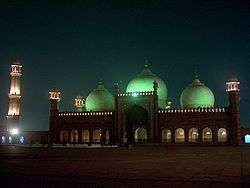
The two Eids, Eid ul-Fitr and Eid ul-Adha, commemorate the passing of the month of fasting, Ramadan, and the willingness of Ibrahim to sacrifice his son Ismael for Allah. On these days, there are national holidays and many festival events that take place to celebrate Eid. As Pakistan is a Muslim state, there are three days off for all businesses and government offices.
On the night before Eid, people search for the new moon to mark the end of Ramadan and arrival of Eid ul-Fitr. The day starts with morning prayers, then returning home for a large breakfast with family members. The day is spent visiting relatives and friends and sharing gifts and sweets with everyone. During the evening, Pakistanis often party, visit restaurants or relax in city parks.
On Eid ul-Fitr, money is given for charity and as gifts to young children.
On Eid ul-Adha, people may also distribute meat to relatives and neighbors and donate food to charity.
Milaad un Nabi
Milaad un Nabi is a known religious festival which is celebrated in all over Pakistan. The Milaad is the celebration of the birthday of the Islamic last prophet Muhammad.
Muharram (Ashura)
Muharram is a month of remembrance and modern Shia meditation that is often considered synonymous with Ashura. Ashura, which literally means the "Tenth" in Arabic, refers to the tenth day of Muharram. It is well-known because of historical significance and mourning for the martyrdom of Hussein Ibn Ali, the grandson of Muhammad[9]
Shias begin mourning from the first night of Muharram and continue for ten nights, climaxing on the 10th of Muharram, known as the Day of Ashura. The last few days up until and including the Day of Ashura are the most important because these were the days in which Imam Hussein and his family and followers (including women, children, and elderly people) were deprived of water from the 7th onward and on the 10th, Imam Hussain and 72 of his followers were martyred by the army of Yazid I at the Battle of Karbala on Yazid's orders. The surviving members of Imam Hussein's family and those of his followers were taken captive, marched to Damascus, and imprisoned there.
With the sighting of the new moon, the Islamic New Year is ushered in. The first month, Muharram is one of the four sacred months that [Allah] has mentioned in the Quran.
Jashn-e-Baharan
Jashn-e-Baharan sometimes referred to as Basant, is a pre-Islamic Punjabi festival that marks the coming of spring. Celebrations in Pakistan are centered in Lahore, and people from all over the country and abroad come to the city for the annual festivities. Kite flying competitions took place all over the city's rooftops during Basant but are now prohibited. The fertile province of Punjab was intimately tied via its agriculture to the different seasons of the year. The arrival of spring was an important event for all farmers and was welcomed with a celebration, hence the name Jashn (celebration) Baharan (spring).{Citation needed|date=September 2013}
Independence Day
On 14 August, the people of Pakistan celebrate the day when Pakistan gained its independence from British India and became an independent state for Muslims of South Asia. The day begins with gatherings and prayers in mosques all across Pakistan in which people pray for the betterment and success of their country. Early in the morning, a 21 cannon salute is given to all those who contributed and lost their lives for attaining Independence. Flag hoisting ceremonies are held in the capital Islamabad and all capital cities of other provinces. Mega-events are organized all across the country, in which the people of Pakistan sing their national anthem and famous classical and pop singers sing various patriotic songs. Famous governmental and private buildings are decorated with lights and the day is concluded by a spectacular firework in Major cities of Pakistan.
Defense Day Parade
September 6 is another patriotic day when the Army of Pakistan displays Pakistani weaponry to the general public. All government officials attend the ceremony and recognitions are awarded to special people for their work. In March 2007, the Pakistan Air Force (PAF) displayed the new jointly manufactured Chinese-Pakistani aircraft called the JF-17 Thunder.
Popular media
Television
Traditionally, the government-owned Pakistan Television Corporation (PTV) has been the dominant media player in Pakistan. The PTV channels are controlled by the government and opposition views are not given much time. The past decade has seen the emergence of several private TV channels showing news and entertainment, such as GEO TV, AAJ TV, ARY Digital, HUM, MTV Pakistan, and others. Traditionally the bulk of TV shows have been plays or soap operas, some of them critically acclaimed. Various American, European, Asian TV channels, and movies are available to a majority of the population via Cable TV. Television accounted for almost half of the advertising expenditure in Pakistan in 2002.[10]
Radio
The Pakistan Broadcasting Corporation (PBC) was formed on 14 August 1947, the day of Pakistani independence. It was a direct descendant of the Indian Broadcasting Company, which later became All India Radio. At independence, Pakistan had radio stations in Dhaka, Lahore, and Peshawar. A major programme of expansion saw new stations open at Karachi and Rawalpindi in 1948, and a new broadcasting house at Karachi in 1950. This was followed by new radio stations at Hyderabad (1951), Quetta (1956), the second station at Rawalpindi (1960), and a receiving center at Peshawar (1960). During the 1980s and 1990s, the corporation expanded its network to many cities and towns of Pakistan to provide greater service to the local people. Today, there are over a hundred radio stations due to more liberal media regulations.
Cinema
Pakistan's movie industry is known as Lollywood, named after the city of Lahore. Film production centers also exist in Karachi and Peshawar. The Pakistani film industry produces over forty feature-length films a year. Bollywood films are also popular in Pakistan but with recent bad relations with India, they tend to be on the cinema screen much lesser than they used to do.
National dress
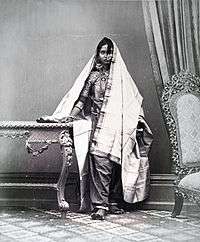
The national dress is shalwar kameez for both men and women. It consists of a long, loose fitting tunic with trousers baggy enough to not to see the shape of their legs.[11]
References
- Basham, A.L. (1968), Pacific Affairs, University of British Columbia, 641-643
- Dehejia, Vidja South Asian Art and Culture. The Metropolitan Museum of Art. Retrieved on 10 February 2008
- The Indus Valley And The Genesis Of South Asian Civilization Archived 9 June 2012 at WebCite Retrieved on 6 February 2008
- Architecture in Pakistan: A Historical Overview Archived 16 January 2009 at the Wayback Machine. All Things Pakistan. Retrieved on 10 February 2008
- UNESCO World Heritage State Parties Pakistan Retrieved 9 July 2010.
- World Hockey Archived 3 April 2007 at the Wayback Machine, International Hockey Federation
- "Committee on Commodity Problems: Tea Market Studies-Egypt, Islamic Republic of Iran, Pakistan and Turkey". Fao.org. 22 July 2005. Retrieved 7 June 2018.
- Three Cups of Tea: One Man's Mission to Promote Peace One School at a Time, by Greg Mortenson and David Oliver Relin, Penguin Books, NY, 2006, p. 150.
- "Muharram". 8 December 2010. Retrieved 8 December 2010.
- http://www.warc.com/LandingPages/Data/NewspaperTrends/PDF/Pakistan.pdf Archived 6 October 2007 at the Wayback Machine
- Koerner, Stephanie; Russell, Ian (2010). Unquiet Pasts: Risk Society, Lived Cultural Heritage, Re-designing Reflexivity. Ashgate Publishing, Ltd. ISBN 978-0-7546-7548-8.CS1 maint: ref=harv (link)
